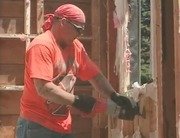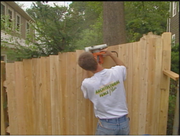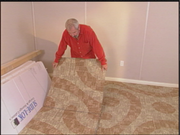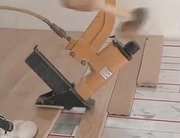Hi, I'm Bob Vila.
Welcome to the show here in the little town of Melrose, Massachusetts.
Our eighty-five year old house is getting some serious improvements to the lot today.
We're gonna be looking at hard scape solutions to some of problems we had here.
Including putting in a beautiful retaining wall, using salvaged granite.
And in the back yard removing an enormous tree that's a bit of a problem.
And we found a little insect damage.
Stick around, good to have you with us.
OK, so there's a lot of landscaping work that we're doing to the house and part of it is what they call hard scape.
Right, Nick?
Right.
Nick Christie is here from Atlantic View and they're installing a new, I guess you'd have to call a retainer wall.
Sure.
Or we call it, in this case, it's almost a glorified curb.
Alright.
Yeah, it's a glorified curb because it's granite.
Tell me about the stone and where it comes from.
This is antique granite that we got out of the salvaged Damder State Hospital.
They had dismantled a good portion of the hospital and now they're building condos up there, and when we showed up on the site, there was a mountain of this antique granite and we purchased it and hauled it back to our yard in East Freetown.
It's about 40 trailer right on pulse.
Now what I love about it is the fact that it's all been done by hand.
You can almost see the chisel marks and the split marks.
From when they were working this material a hundred years ago.
Yeah, it's an old weathered granite and it was probably part of the foundation at one time.
There was stairs, windowsills, window lentils.
We have all kinds of chiseled and faced pieces.
We have more rustic pieces, like you see here.
Now on the side of the house we used to have a concrete walk that was probably as old as the house, and the tree roots had broken it up and moved it all over the place.
You've gotten rid of it.
Tell me what the plan is over there.
Well , we got rid of the walk and the stairs, and we brought the granite in to create the stairs, and then what we're going to do is, we are going to put a compacted stone dust, with about a half inch of a small pebble, either a half inch aggregate or a rice stone, bordered by a steel edging., and it'd be a little more relaxed walkway up to the back...
But you've also used other pieces of this granite back there, haven't you?
We have.
We used it to terrace up the side of the house where they're gonna have some storage bins and that gives them some flat spaces to work with.
Great, that's gonna be very nice, because it's a rustic, it's not like a city treatment.
It's more of a country treat.
Exactly.
Now, over here I noticed that you have repositioned the stones, I mean, it's so simple.
It looks really beautiful to create the two steps.
How do you work this stuff?
I mean, do you have to, there's no cement that's been used, right?
No, we dry set it, we dug a trench and we put in about a foot of compacted aggregate.
We set the.
How deep are these stones set?
Am I looking at the bottom of them, or is there another half a foot in there?
These go about another six to eight inches below grade to sort of help anchor them.
They were big pieces anyway and we didn't need that much rise here.
So, that's a good idea to bury some portion of it.
We cut them with a diamond blade on a portable saw.
Sometimes, well, when you cut, you get a smooth clean cut.
We like to to flame that with a torch, and chisel the edges to make it look natural and antique again.
Okay, and you don't have to worry about the frost heaving these out of place?
No, they might lift a little, but they'll settle back down, and as you can see it's not, it's not an absolute perfect situation.
They're sort of a little bit bumpy here and there and it's just the way that...just like a city curb.
So we've got two steps up to what was just a lawn that sloped down to the sidewalk.
Now, what we've created here is kind of a raised bed bordered by the old granite curb, and then we're gonna have a natural field stone pathway stepping through here to bring you around to the back.
So, you'll really be walking through a garden, right?
Exactly.
Let's look at what you have done in the back.
Okay, so in the back yard, we had an existing stone installation that the homeowners had put in, which is very attractive the way it's weathered.
And what are you guys building in addition to that?
Trying to keep with the same relaxed feel as they started here.
And what we're doing is we're outlining this French Patio with some natural field stones and consists of a compacted gravel base, layered with some stone dust.
And then finally about a half inch of small, aggregated pebbles again like our walkway.
Just embedded into that surface.
Alright, so these big stones, these nice, flat stones are just laid loose?
Yeah.
You don't have to cement them.
They're gonna be laid in stone dust, dry, dry set.
I see.
And you don't have to worry about that gravel or pea stone flying all over the place?
No, it's a very thin layer and we run the compactor over it.
And we embed into the stone dust that's below.
Mmhm.
And it's just a thin layer, it's not a very thick layer of it.
Sounds beautiful, I mean I know the look of European courtyards with the little gravel like that in France.
It's very pretty.
Now, what about flooding?
We're kind of like the low man here.
We've got a hill.
side behind us and traditionally there's rain water that comes in this direction.
And taking that into consideration, in a flat site there is really nowhere for the water to pitch off and run without sloping the patio too much, so what we created underneath here was a sloped sub grade and we put in a perforated pipe crushed stone, wrap that in filter fabric, and that's below this center of this whole terrace here.
So that, technically, should handle all the runoff from the hillside.
Exactly.
And take it away down through towards the street, towards the city sewers.
So this is all pervious material and that and rainwater will all just perk in and it will run out through the side.
I think it's a great design because it's really a nice alternative to the traditional American backyard.
It's going to be very, very pretty when it's done.
Thanks, Nick.
Thank






